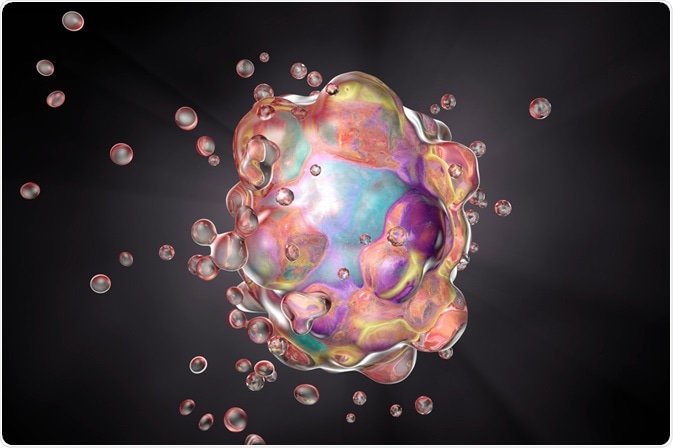Proper, efficient regulation of cellular development is essential for a living organism. Cells have to constantly be removed and recycled, with new cells replacing them all the time. One such process that occurs over the natural lifespan of an organism is apoptosis, a crucial process that has been studied intensely over recent years.
 Image Credits: Kateryna Kon / Shutterstock.com
Image Credits: Kateryna Kon / Shutterstock.com
Apoptosis – an overview
Apoptosis is the process of controlled cellular “suicide”. Whereas in necrosis cells die due to injury or disease, apoptosis is a natural part of the regulation and development of the body’s biological processes. It is a complex but orderly process that serves many functions, and abnormalities in the process can lead to disease.
For example, the separation of individual fingers in the fetal stage is due to apoptosis of the cellular material between them. If this were not to occur, the fetus would end up with either “webbed” fingers or just a pad of tissue where the hand would be.
Apoptosis produces apoptotic bodies, which are cell fragments that are then engulfed by phagocytic cells. This removes the fragments before they can spread into surrounding tissue, potentially causing damage.
Apoptosis pathways
There are two pathways that can initiate apoptosis in a cell: the intrinsic and extrinsic pathways. In the intrinsic pathway cellular stress, once detected, causes the cell to self-initiate apoptosis. In the extrinsic pathway, apoptosis is initiated by external signals from other cells. The intrinsic pathway can also be activated by weak external signals.
Mitochondria play an essential role in the intrinsic pathway. They act by activating by the release of proteins from the intermembrane space, which can occur due to mitochondrial swelling and the formation of membrane pores or by increased permeability of the membrane, which causes apoptotic factors to leak out of the mitochondria.
The main extrinsic mediator of apoptosis is TNF-alpha, a cytokine that is produced by activated macrophages. The cytokine binds to the TNFR1 and TNFR2 receptors, which are present in most human cells. The Fas pathway (which involves the fas – fast apoptosis signal – receptor, a transmembrane protein) is another initiator for the extrinsic pathway. Through interaction between Fas and FasL (the Fas ligand), the DISC (death-inducing signaling complex) is formed. A feedback loop increases the release of proapoptotic factors from the mitochondria, thus starting the process of cell death.
Cell death is induced by both pathways through the activation of caspases, which are enzymes that degrade proteins. There are two types of caspases: inhibitor caspases and executioner caspases (inhibitor caspases activate the executioner caspases). The cell is then killed by the indiscriminate degradation of proteins. The end process of apoptosis is the packaging of cell organelles and proteins into membrane-bound blebs (or chunks), which are then consumed and removed by phagocytes.
Apoptosis in physiological development
Apoptosis plays a significant role in an organism’s physiological development. As mentioned, the development of fingers and toes from the initial fetal “paddle” is due to apoptosis in the tissues between them. A tadpole losing its tail is another example of a process that is mediated by apoptosis. Apoptosis also plays a part in the development of the brain by removing unneeded neurons.
The average adult human loses somewhere between 50 to 70 billion cells per day through the process of apoptosis. In this way, cells are constantly being removed as they no longer become necessary or reach the end of their life, allowing for the growth of new cells and their replacement.
Age-related increases in apoptotic lymphocytes lead to the increased death rate of cells in the bone marrow and the thymus, and this increased rate of apoptosis is one of the significant factors in aging itself. Apoptosis plays a significant role in the immune system.
Abnormal apoptosis
Many factors can play a role in increased or decreased rates of apoptosis, which can have detrimental effects on the organism. Perturbations in the process are linked to disease, infection, and abnormal physiological processes. For example, if a cell is not removed by apoptosis, and therefore lives longer than it should have, it can develop defective characteristics that can lead to it becoming diseased or cancerous.
Recent research has shown how disruption of apoptosis occurs in NCI-H460, a type of lung cancer. In the H460 cell line, XIAP (X-linked inhibitor of apoptosis protein) is overexpressed. XIAPs bind to caspase-9 (specifically, the processed form) and cause an imbalance of anti-apoptotic and proapoptotic effectors. Damaged cells continue to replicate, leading to their cancerous mutations.
Inhibition of apoptosis results in various cancers, autoimmune diseases, and viral infections. Hyperactive apoptosis can lead to tissue damage, neurodegenerative diseases, and hematologic diseases. This includes Alzheimer’s and Parkinson’s. HIV infections are linked to unregulated, hyperactive apoptosis.
Abnormal apoptosis has also been linked to degenerative heart conditions such as cardiomyopathy, paroxysmal arrhythmias, arrhythmogenic right ventricular dysplasia, and conduction disturbances that may be responsible for sudden death.
Apoptosis – a critical but poorly understood physiological process
Apoptosis is a part of the normal development of an organism that is still not clearly understood. Due to its role in disease susceptibility, regulation of natural cell death, and its critical role in the immune system, researchers are studying this essential process to develop new treatments and drug therapies that involve the manipulation of the pathways involved.
Sources
James, T.N. (1994) Normal and abnormal consequences of apoptosis in the human heart: from postnatal morphogenesis to paroxysmal arrhythmias Trans Am Climatol Assoc. 105 Pgs. 145-178 https://www.ncbi.nlm.nih.gov/pmc/articles/PMC2376730/
Green, D.R and Reed, J.C. (1998) Mitochondria and Apoptosis Science Vol. 281, Issue 5381, pp. 1309-1312 https://science.sciencemag.org/content/281/5381/1309
Tower, J. (2015) Programmed cell death in aging Ageing Res Rev. 23 (Pt. A) 90-100 https://www.ncbi.nlm.nih.gov/pmc/articles/PMC4480161/
Carson, D.A. and Ribero, J.M. (1993) Apoptosis and disease The Lancet Vol. 341, Issue 8855 Pgs. 1251-1254 https://www.sciencedirect.com/science/article/pii/014067369391154E
Liling Yang et al. (2003) Predominant Suppression of Apoptosome by Inhibitor of Apoptosis Protein in Non-Small Cell Lung Cancer H460 Cells Cancer Research Vol. 63, Issue 4 https://cancerres.aacrjournals.org/content/63/4/831.long
Further Reading